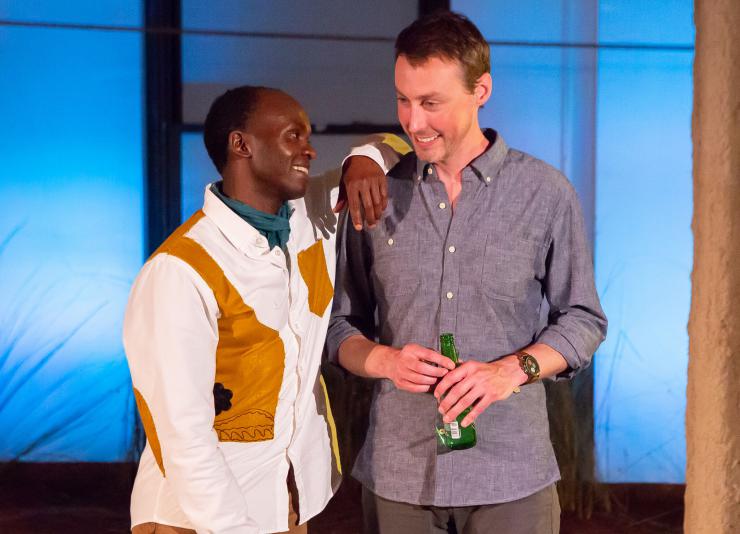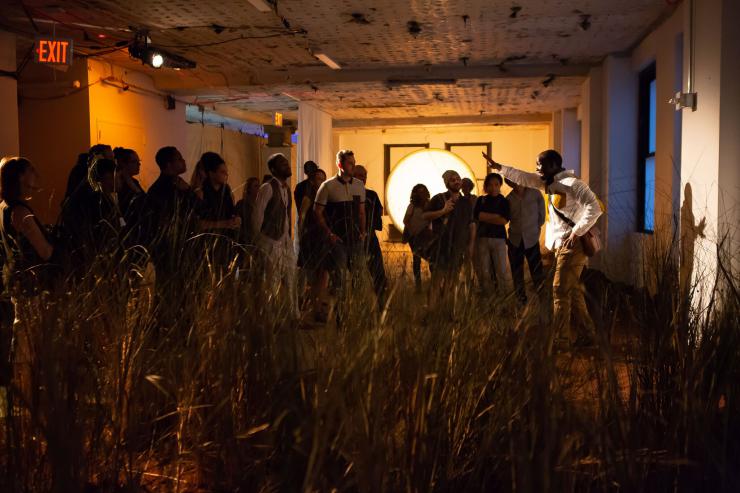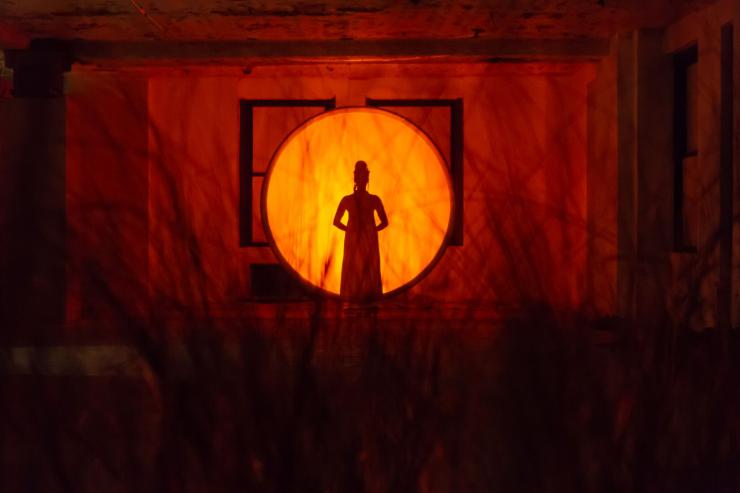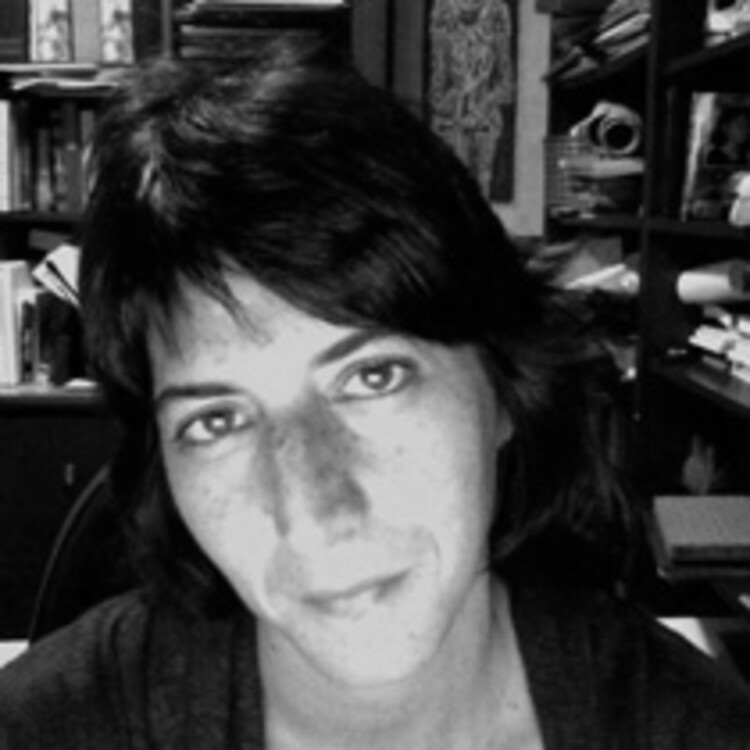Red Hills and the Question of Who Gets to Tell What Stories
Who has the right to tell what stories? And for whom? Who benefits?
These questions are at the heart of En Garde Arts’ most recent theatrical off-site exploration, Red Hills, a play written by Asiimwe Deborah Kawe and Sean Christopher Lewis. Staged in a converted office building in Lower Manhattan by director Katie Pearl, the piece centers on two characters, both witnesses to the Rwandan Genocide. One is David Zosia (Christopher McLinden), a white kid who never left Ohio except when he traveled as a teenage missionary to the Uganda/Rwanda border to participate in building homes for a local Ugandan village; the other is God’s Blessing (Patrick J. Ssenjovu), a native of Byumba, the northern Rwandan town just south of the border, who was only sixteen when his family was murdered by the Hutu militiamen in April of 1994.
As the audience exits the elevators on the ninth floor at 101 Greenwich Street, where the show takes place, we enter the reception of the soon-to-be offices of Peace Building Hub, the new NGO founded by Zosia (or, as he introduces himself, Dr. David Zosia, after writing a doctoral dissertation titled “Meaning of Forgiveness after Trauma”). After we mill around the bar sipping cocktails and loom over what seems like a generic exhibit featuring photos and artifacts from various African countries, we gather and sit in comfortable white chairs set in straight rows to listen to Zosia’s welcoming. Wearing a spiff grey suit with a silk blue handkerchief for the occasion, he stands behind a miked lectern prepared for the occasion. He tells us about his life’s work. How he has traveled the world helping others. Listening to others. How his new NGO will help survivors of trauma in war-torn countries. He is soft-spoken and well meaning.

Zosia, we learn, wrote an award-winning New York Times bestselling book called Dogs of Rwanda, where he chronicled his experience as a young missionary and his sudden and unexpected encounter with God’s Blessing, a boy his age, who had just lost his parents in the midst of the violence. “I care so much for this boy,” he reads from his book, “this boy I just met, this boy from half a world away. Yet he is my neighbor. My brother. I put my arm across his shoulders and his lean body almost throws me off balance. But I promise myself I will not let God’s Blessing fall.”
Despite its veil of altruism, the Peace Building Hub scene and Zosia’s unasssuming demeanor have an oddly familiar, oddly uncomfortable feel to it—the cliché of the white savior raising money for third-world countries over a feel-good champagne benefit and Power Point presentation. Given its staging in this locale, it feels as though we are participants at the event as opposed to spectators at a theatre show. “Is this for real?” my friend whispers in my ear next to me.
It is around this moment that God’s Blessing appears. We see him riding his bike, circling the space, and he disappears as quickly as he entered. He is there to illuminate Zosia’s book; he is a romanticized memory from Dogs of Rwanda.
When Lewis, an American playwright, had asked if she would be interested in producing his one-person show, Dogs of Rwanda, she said yes on condition of changing the title, developing it into a two-character play with the collaboration of a creative voice from the region—Ugandan playwright Kawe—and, finally, staging it site-specifically.
The play’s opening ceremony is just long enough to show the West’s desire to “do good” and to stress our own complicity in these self-centered, well-intentioned retellings of history—the kind of story that plays out, and gets told, in real life over and over again. Who is God’s Blessing? What is his story? And why does Zosia get to tell it?
When God’s Blessing re-enters the space, he congratulates Zosia on his book in Kinyarwanda, one of the official languages of Rwanda, and directly greets the audience. Zosia is surprised that God’s Blessing is still alive. Once he had returned to the States, Zosia never bothered to reach out to God’s Blessing; at one point later in the play he confesses: “I made money from the book. If I’d known you were alive I’d have given money to you”.
God’s Blessing had survived the fateful morning in April of 1994 when he lost his parents, aunt, and sister, who were massacred along with almost 800,000 other Tutsis by Hutus, often inside the very churches that were supposed to serve as shelters from the horror, as nuns and priests allowed the killings and the West turned a blind eye. He is now married and a proud father to a young boy named Nelson. He is a tour guide, founder and CEO of Guhahamuka Tours and Travel Company. He hands out his business cards. “I work with people like you all the time, mostly white,” he tells Zosia, and us, as he graciously escorts us out of our seats.
So begins our journey into Rwanda’s past and present with our guide, God’s Blessing.

Along with Zosia, the audience slowly visits the rest of the vast office space, which has been transformed with mounds of red dirt, dim lighting, and Rwandan-inspired sound and music played live by composer and musician Farai Malianga and vocalist Sifiso Mabena. We stop at an installation that represents the Ntarama Church, located south of Kigali and which is now a genocide memorial site. Here, God’s Blessing tells us, thousands of Tutsis perished as grenades were systematically launched through the church’s walls. We peek inside but do not go in. There are blood stains. An array of clothes of all colors and sizes hang horizontally across the walls. Human remains were stored there, we learn.
Eventually, we seat ourselves in chairs set in a semicircle, near huge windows with a view of the Manhattan skyline, to witness God’s Blessing coerce Zosia, through a series of flashbacks and reenactments, into confronting the truth about what really happened to them during the Rwandan genocide. “You want to tell our stories. You want to make yourself only the hero. I show you real heroes,” he tells Zosia. Eventually, Zosia comes to realize that he appropriated God’s Blessing’s story and apologizes.
RED HILLS’s dramaturgical choice to emphasize the relationship between Zosia and God’s Blessing—and through them the appropriation of stories and who gets to tell them—is timely, in particular given the current slough of art controversies in the news.
A few Western theatre artists have previously tackled dramatizing the Rwandan genocide. Two monumental productions stand out for their approach to theatricalizing the trauma of an “other.” In 2010, Swiss director Milo Rau premiered Hate Radio, a performance that recreated the real-time broadcasts of Rwandan radio station Mille Colline (RTLM) with Tutsi survivors playing the roles of the Hutu extremist hosts. Initially, after months of research, Rau found it “impossible to sum up something so incomprehensible in a performance” and decided to call off development. Eventually, however, he and his production company, the International Institute of Political Murder (IIPM), decided to use the verbatim transcripts from RTLM, which were broadcast during the genocide to instill hatred, as a way to unveil how racism functions and how quickly it can spread.
In another case, American playwright Erik Ehn developed Soulographie, a series of seventeen plays that looked at twentieth century America from the point of view of its relationship to genocide. The durational event, which premiered at LaMama in 2012 with the entire performance cycle, was accompanied by an extended series of cultural exchanges over the years between United States and Rwanda to foster art and social change that have had a lasting cultural impact.

Red Hills’s dramaturgical choice to emphasize the relationship between Zosia and God’s Blessing—and through them the appropriation of stories and who gets to tell them—is timely, in particular given the current slough of art controversies in the news (like Robert Lepage’s SLĀV, Dana Schutz’s painting Open Casket, and Brett Bailey’s Exhibit B).
When I asked Anne Hamburger, En Garde Arts’ founder and hands-on creative director, about the impetus for producing this piece, she explained how “it comments on well-meaning intentions of Americans who want to do good—[but] who do harm and [who] profit from culture without doing good.” When Lewis, an American playwright, had asked if she would be interested in producing his one-person show, Dogs of Rwanda, she said yes on condition of changing the title, developing it into a two-character play with the collaboration of a creative voice from the region—Ugandan playwright Kawe—and, finally, staging it site-specifically. “Americans are so culpable when it comes to big business, aligning themselves with dictators around the world,” she told me. “I loved the visual contradiction of a grassy field in Rwanda in a disused office building in the financial capital of the world.”
This juxtaposition did carry over, and even felt a little jarring. There we were, journeying through Rwanda’s tragic past with views of the spectacular Manhattan skyline. We were somehow implicated, even if the suffering was far away. It reminded me of the West’s decision not to intervene during the genocide, even when they knew the extent of the killings.
The production raised a complexity of issues regarding postcolonial histories, the aftermath of war and genocide, truth and reconciliation, and the co-option of the pain of others for one’s own personal gain despite having the best intentions in mind. At the end of the show, Zosia apologizes and abruptly exists, seemingly relieved that God’s Blessing forgives him (remember Dr. Zosia’s dissertation title?). In retrospect, I wish Zosia hadn’t been absolved. Why should we get off that easily? Why should we feel closure when there is none?


Comments
The article is just the start of the conversation—we want to know what you think about this subject, too! HowlRound is a space for knowledge-sharing, and we welcome spirited, thoughtful, and on-topic dialogue. Find our full comments policy here